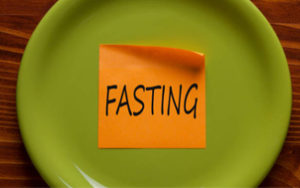Intermittent fasting is a term you have probably heard before but may not know exactly what it means. When you hear the word fasting, you may think of another diet plan that will deprive you of nutrients and leave you feeling hungry and miserable throughout the day. However, intermittent fasting does not cause any of these feelings. Instead, this type of regimen works to help you get more in control of your eating, in turn helping you reach your health goals while feeling your energetic best.
So, what is intermittent fasting?
 There are many different programs out there that use intermittent fasting as their foundation. At the core of each program is a cycle of eating and fasting that hopes to help the body regulate its circadian rhythm, improve gut health, and to improve patterns of eating, activity, and sleeping. Here are the major types of intermittent fasting:
There are many different programs out there that use intermittent fasting as their foundation. At the core of each program is a cycle of eating and fasting that hopes to help the body regulate its circadian rhythm, improve gut health, and to improve patterns of eating, activity, and sleeping. Here are the major types of intermittent fasting:
- Alternate Day Fasting: This type of fasting alternates full “fasting days,” in which no calorie-containing foods or drinks are consumed, with days in which foods and beverages are consumed without restriction. The theory of this regimen is that like caloric restriction, this alternate fasting would help lower fasting insulin and glucose levels in the body.
- Modified Fasting: Modified fasting involves periods of eating a very low-calorie diet alternating with periods of “normal” and unrestricted eating. Examples of this type of regimen include the popular 5:2 diet that involves a low-calorie diet for two non-consecutive days a week alternated with five unrestricted days.
- Time-Restricted Feeding: This type of intermittent fasting is among the most popular in recent times. It involves daily fasting intervals that range from 12 to 20 hours. Many of these regimens use a nighttime fasting interval, in which feeding stops at some time in the evening and does not resume until sometime later in the morning. During this fasting time, no calories, except for non-caloric beverages, are consumed.
What does the research say?
 Preliminary studies show promise for intermittent fasting to help improve blood glucose levels, insulin levels, and improving blood fat levels such as cholesterol and triglycerides. In addition, some fasting studies have also shown weight loss and improvements in metabolic factors such as stimulating the browning of fat.
Preliminary studies show promise for intermittent fasting to help improve blood glucose levels, insulin levels, and improving blood fat levels such as cholesterol and triglycerides. In addition, some fasting studies have also shown weight loss and improvements in metabolic factors such as stimulating the browning of fat.
You may ask, “I don’t care what color my fat is. I just want to get rid of it.”
Brown fat is different from white fat since it contains iron-containing mitochondria in them, which gives them their brown color. It also has more capillaries than white fat cells, because they have increased oxygen needs. Brown fat is found mostly in the neck, and those that have more of it tend to have higher cold tolerance and are more likely to not be overweight than those with lower brown fat levels.
This is because brown fat may affect metabolism. A 2017 study looked at the metabolic effects of an intermittent fasting regimen on mice. Not to get too scientific, but this study found that fasting periods of one day of fasting followed by two days of feeding led to a process called vascular endothelial growth factor in adipose tissues, or adipose VEGF in mice. This process aided in the browning of white adipose tissue.
So, what about the research on humans?
 More studies need to be done to see if the adipose tissue responds in the same way to intermittent fasting. Some studies have found that alternate day fasting and modified fasting can both lead to weight loss. There are not enough studies though to show if this weight loss is significantly different than continuous calorie reduction diets.
More studies need to be done to see if the adipose tissue responds in the same way to intermittent fasting. Some studies have found that alternate day fasting and modified fasting can both lead to weight loss. There are not enough studies though to show if this weight loss is significantly different than continuous calorie reduction diets.
Alternate day fasting has also shown significant improvements in glucose and insulin levels in the blood. However, alternate day fasting was also shown to be impractical for many since it involves full days of not eating that can lead to intense hunger and discomfort.
The bottom line is that there is simply not enough comprehensive research on intermittent fasting in humans to show effects on diet, sleep patterns, activity, or improved clinical outcomes such as reduced disease risk. Also, most studies have been on non-overweight individuals, so more studies on overweight and obese populations still need to be done to see if intermittent fasting could have long-term benefits for these individuals.
Should I try intermittent fasting?
 There are some benefits to intermittent fasting ranging from weight loss to increased energy to reduced cravings to improved blood glucose profiles, so there are some pros to this eating regimen. Research has also shown that there are limited reports to any negative mood changes in relation to this eating regimen, but review of such information is still in its earlier stages. Therefore, unless your healthcare provider feels it may be unsafe for you to try due to medications or other medical treatments you may be involved in, then intermittent fasting should be safe to try.
There are some benefits to intermittent fasting ranging from weight loss to increased energy to reduced cravings to improved blood glucose profiles, so there are some pros to this eating regimen. Research has also shown that there are limited reports to any negative mood changes in relation to this eating regimen, but review of such information is still in its earlier stages. Therefore, unless your healthcare provider feels it may be unsafe for you to try due to medications or other medical treatments you may be involved in, then intermittent fasting should be safe to try.
References:
1. Patterson, R.E., et al. (August 2015) “Intermittent Fasting and Human Metabolic Health.” Journal of the Academy of Nutrition and Dietetics, 115(8): 1203-1212.
2. Patterson, R.E. and Sears, D.D. (August 2017) “Metabolic Effects of Intermittent Fasting.” Annual Review of Nutrition, 37: 371-393.
3. Kirkpatrick, MS, RD, LD, K. (October 23, 2015) “Intermittent Fasting Has Benefits Beyond Weight Loss.” https://health.clevelandclinic.org/interested-fasting-health-get-facts-first/
4. Kim, K-H., et al. (2017) “Intermittent fasting promotes adipose thermogenesis and metabolic homeostasis via VEGF-mediated alternative activation of macrophage.” Cell Research, 27: 1309-1326.
5. Nordqvist, C. (March 9, 2017) “Brown fat: what is it and can it help reduce obesity?” Medical News Today, https://www.medicalnewstoday.com/articles/240989.php
6. Harvie, M. and Howell, A. (2017) “Potential Benefits and Harms of Intermittent Energy Restriction and Intermittent Fasting Amongst Obese, Overweight and Normal Weight Subjects—A Narrative Review of Human and Animal Evidence.” Behavioral Sciences, 7, 4; doi:10.3390/bs7010004.
7. Donovan, M. (May 1, 2018) “I Tried Intermittent Fasting for 10 Days, and This Is What Happened.” https://www.eatthis.com/what-happens-during-intermittent-fasting/

